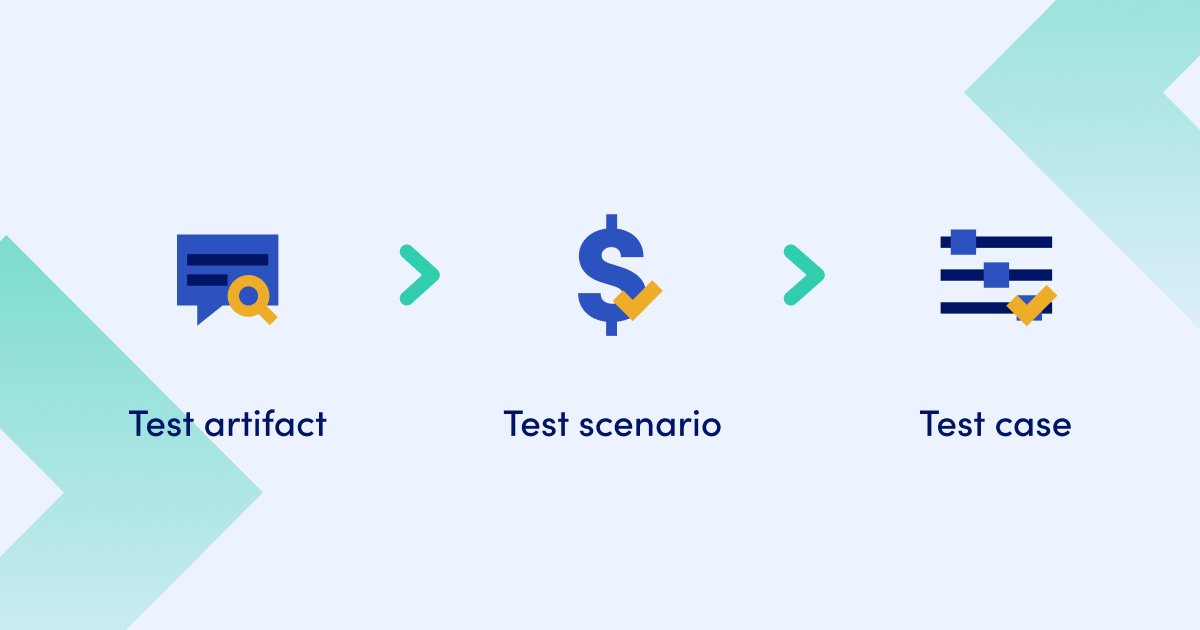
Knowing the elements of testing will help make testing a feature or the entire system more efficient, minimizing failures that can affect the system and the business.
Some of the basic elements of any testing are test scenarios and test cases. Even though a test case is an element of a test scenario, both test-related items have different purposes and components. So, what is the difference between them? But first, let's analyze each concept separately.
What is a test scenario?
Generally speaking, test scenarios refer to any functionality of the system that can be tested: placing an order, logging into the system, money transfer, etc. It is a description or outline of a situation, condition, functionality, or feature to be tested. Test scenarios involve answering the question “What needs to be tested” without going into detailed steps.
The main components of test scenarios are:
- Name — a unique name or identifier that provides a quick reference.
- Objective — clearly states the purpose or goal of the test scenario, outlining what needs to be achieved.
- Conditions — describes the preconditions or prerequisites necessary for executing test scenarios successfully.
- Input data — specifies the input values, conditions, or actions required for the test scenario. This includes any data or information necessary to perform the test.
- Expected results — defines the anticipated outcomes or behavior after executing test scenarios. This helps determine whether the system functions as expected.
Example of a test scenario
Let's consider a scenario for the "order placement" feature of an e-commerce website:
Scenario name — online order placement.
Objective — verify that a user can successfully place an order on the e-commerce website.
Conditions:
- The user has a registered account on the e-commerce platform.
- The user is logged in to their account.
- The website is accessible and responsive.
- The product is available in inventory.
Input data:
- Product details (name, quantity, size, color).
- User's shipping address and payment details.
Expected results:
- The order is successfully placed.
- The user receives an order confirmation.
- The ordered product is deducted from the inventory.
The scenario may also include the following optional elements:
- Preconditions — the user has successfully logged in.
- Postconditions — the user's order is registered in the system, and the inventory is updated.
What is a test case?
Simply put, it's a certain more detailed part of the test scenario.
Going into detail, test cases are a set of detailed instructions or conditions that a tester follows to execute a specific test regarding a software application. The purpose of test cases is to verify whether the software behaves as intended under certain conditions, ensuring that it meets the specified requirements.
Test cases consist of the following core elements:
- Preconditions required for initiating the test.
- Any input data needed for the test.
- The action or operation to be carried out.
- The expected results of the test, which may encompass outputs or alterations in the existing conditions.
Whereas a more detailed components of test cases might look like this:
- Test case name — a unique identifier or name.
- Description — a detailed description of the test case, outlining its objectives and scope.
- Test steps — a sequential set of actions to be executed during the test.
It’s the main component of test cases, unlike a scenario which usually does not imply steps, being limited only to a general description of the situation or context relevant to the testing.
- Expected result — the anticipated outcome or behavior when executing the test steps.
- Actual result — the actual outcome observed during test execution (filled in after the execution).
- Status — indicates whether the test case passed, failed, or is in progress.
- Priority — the importance assigned to the test cases.
- Test data — specific data or input values required for executing the test.
Example of a test case
Let's take a simple one: checking the operation of the “login” feature:
Test case name: user login.
Inputs:
- Username: your username
- Password: your password.
Steps:
- Open the website's login page.
- Enter the valid username and password.
- Click the "Login" button.
Expected results:
- The user should be successfully logged in.
- The system should redirect the user to the homepage.
- The user's name or profile picture should be visible on the homepage.
The difference between test case and test scenario
Test scenarios provide a broad overview of the conditions or actions that will be tested.
On the other hand, test cases are a detailed set of conditions or variables under which a tester will determine whether a system works as intended.
These two components are preceded by a test artifact. A test artifact is a document created during the testing process to describe test-related activities. Test artifacts include items such as test plans, test cases, test scripts, test data, test logs, and any other documentation that assists in the implementation of the testing process.

4 points highlighting the difference between test cases and test scenarios:
- A test scenario operates at a higher, more abstract level, providing a generalized overview of functionalities to be tested, while test cases are more specific, offering detailed steps and conditions for testing a particular aspect of functionality.
- Scenarios encompass a broader scope, often covering multiple functionalities or features within the application, while test cases have a narrower scope, focusing on a specific functionality or a particular set of conditions.
- Test scenarios describe the purpose or goal of testing without going into the detailed steps of execution, whereas test cases specify the exact steps to be followed, including inputs, expected outcomes, and conditions, to achieve a specific testing objective.
- While a test scenario is not directly executable and serves as a guideline for creating test cases, a test case represents a single, executable unit of testing that can be performed by a tester to validate a specific functionality.
- Test scenarios generally do not include detailed steps. Instead, they provide a high-level description of a particular situation or context within which multiple test cases can be derived.
Therefore, understanding the distinction between test cases and test scenarios is essential for effective test planning and execution. While test scenarios provide a high-level overview of functionalities to be tested, test cases offer detailed steps and conditions for validating individual aspects of functionality. Considering and mastering the nuances of these testing components is key to ensuring a comprehensive and systematic approach to software testing. Ultimately, this will help minimize the risks of system failure in times of vulnerable modifications.
